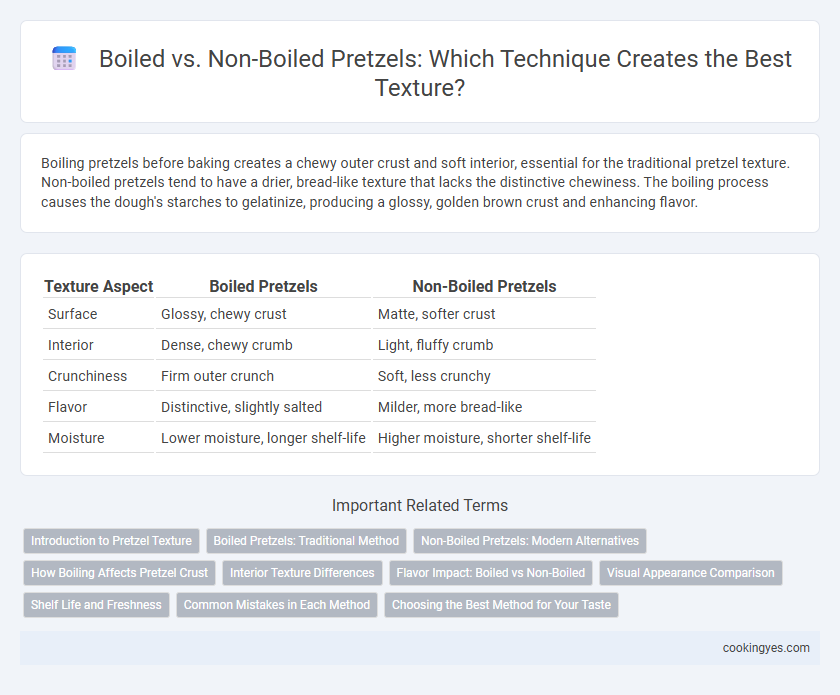Boiling pretzels before baking creates a chewy outer crust and soft interior, essential for the traditional pretzel texture. Non-boiled pretzels tend to have a drier, bread-like texture that lacks the distinctive chewiness. The boiling process causes the dough's starches to gelatinize, producing a glossy, golden brown crust and enhancing flavor.
Table of Comparison
| Texture Aspect | Boiled Pretzels | Non-Boiled Pretzels |
|---|---|---|
| Surface | Glossy, chewy crust | Matte, softer crust |
| Interior | Dense, chewy crumb | Light, fluffy crumb |
| Crunchiness | Firm outer crunch | Soft, less crunchy |
| Flavor | Distinctive, slightly salted | Milder, more bread-like |
| Moisture | Lower moisture, longer shelf-life | Higher moisture, shorter shelf-life |
Introduction to Pretzel Texture
Boiling pretzels before baking creates a distinctive chewy texture and glossy, golden-brown crust due to the Maillard reaction enhanced by the alkaline water bath. Non-boiled pretzels have a softer, bread-like crumb and a paler crust without the characteristic chewiness. This boiling step is essential for achieving the traditional dense and resilient texture that defines classic pretzels.
Boiled Pretzels: Traditional Method
Boiled pretzels achieve their signature chewy texture and glossy, deep-brown crust through a brief dip in boiling water mixed with baking soda before baking. This alkaline bath triggers the Maillard reaction more efficiently, enhancing flavor complexity and creating a distinct, slightly crisp exterior. Non-boiled pretzels lack this chemical transformation, resulting in a softer, less chewy texture and paler crust, which deviates from the traditional Bavarian pretzel experience.
Non-Boiled Pretzels: Modern Alternatives
Non-boiled pretzels, often referred to as baked or dry pretzels, achieve their texture through direct oven baking without the traditional lye or baking soda boil. This method results in a drier, crispier crust and a lighter, airier interior, favored in modern snack varieties like pretzel sticks or crunchy pretzel chips. Non-boiled pretzels offer a convenient alternative to classic boiled pretzels, accommodating diverse flavors and coatings while requiring less preparation time.
How Boiling Affects Pretzel Crust
Boiling pretzel dough in a baking soda solution creates a distinctive crust by gelatinizing the starch on the surface, resulting in a chewy, glossy exterior. Non-boiled pretzels lack this gelatinized layer, producing a softer crust with a more bread-like texture and less crunch. The boiling step is essential for achieving the traditional pretzel crust's signature combination of chewiness and deep golden-brown color.
Interior Texture Differences
Boiled pretzels have a dense, chewy interior due to the gelatinization of starches during the boiling process, which creates a distinct, firm crumb structure. Non-boiled pretzels exhibit a softer, fluffier interior texture as the dough bakes without starch gelatinization, resulting in a lighter, bread-like crumb. This textural difference significantly impacts the eating experience, with boiled pretzels offering a signature chewy bite while non-boiled versions provide a tender, airy mouthfeel.
Flavor Impact: Boiled vs Non-Boiled
Boiling pretzels in a baking soda solution creates a distinctive chewy crust with a deep, slightly alkaline flavor that enhances the traditional pretzel taste. Non-boiled pretzels lack this characteristic crust, resulting in a softer texture and a milder, bread-like flavor profile. The boiling process significantly intensifies the Maillard reaction during baking, producing the classic rich brown color and complex savory notes unique to authentic pretzels.
Visual Appearance Comparison
Boiled pretzels exhibit a glossy, deep brown crust with a distinctive sheen caused by the Maillard reaction triggered during the boiling process. In contrast, non-boiled pretzels display a lighter, matte finish with a more uniform golden color, lacking the iconic pretzel shine. The boiling step also contributes to a thicker, chewier crust, which visually differentiates traditional pretzels from their non-boiled counterparts.
Shelf Life and Freshness
Boiling pretzels in a baking soda solution creates a distinct chewy crust and extends shelf life by sealing moisture inside the dough. Non-boiled pretzels often have a softer texture but tend to stale faster due to increased surface dryness. The boiling step enhances both texture and freshness retention, making boiled pretzels preferable for longer-lasting quality.
Common Mistakes in Each Method
Boiling pretzels before baking prevents a dense, bread-like texture by creating a chewy crust, but common mistakes include boiling too briefly or too long, which results in either a pale crust or overly gummy texture. Non-boiled pretzels often suffer from dry, crumbly interiors and lack the characteristic glossy, chewy crust due to skipping the alkaline bath that promotes Maillard reaction. Proper timing and the use of a baking soda or lye solution in the boiling step are crucial to achieving the ideal pretzel texture.
Choosing the Best Method for Your Taste
Boiling pretzels in a baking soda solution creates a distinctive chewy texture and glossy crust by gelatinizing the dough's surface starches, essential for traditional pretzels. Non-boiled pretzels have a softer, bread-like crumb with a less pronounced crust, appealing to those who prefer fluffier baked goods. Selecting between boiled and non-boiled methods depends on your taste preference for either a classic chewy exterior or a tender, cake-like interior.
Boiled vs non-boiled for pretzel texture Infographic

 cookingyes.com
cookingyes.com